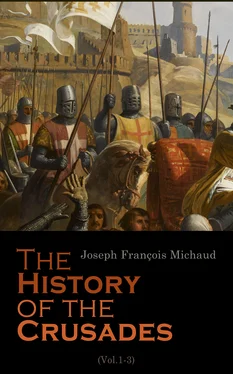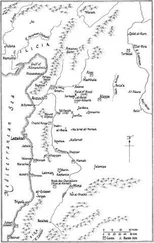The companions of Godfrey and Tancred beat the gate of St. Stephen to pieces with axes, and the city was at once thrown open to the crowd of Crusaders, who pressed forward and contended for the honour of dealing the last blow to the conquered infidels.
Raymond alone still experienced some resistance. Warned of the success of the Christians, by the clashing of arms, and the tumult he heard in the city, he endeavoured still further to animate his soldiers. The latter, impatient to join their companions, abandoned their tower and machines, which they could no longer move. They planted ladders and swords, by the means of which they mounted the rampart, whither they were preceded by the count of Thoulouse, Raymond Pelet, the bishop of Bira, the count de Die, and William de Sabran. Nothing now could stop their progress; they dispersed the Saracens, who with their emir had taken refuge in the fortress of David, [177]and soon all the Crusaders united in Jerusalem embraced, wept for joy, and gave all their attention to the completion of their victory.
Despair, however, for a moment forced the bravest of the Saracens to rally, and they charged with impetuosity the Christians, who, in the security of victory, were proceeding to the pillage. [178]The latter were even beginning to give way before the enemy they had so recently conquered, when Everard de Puysaie, of whom Raoul de Caen has celebrated the bravery, revived the courage of his companions, placed himself at their head, and once more spread terror among the infidels. From that moment the Crusaders had no more enemies to contend with. History has remarked that the Christians entered Jerusalem on a Friday, at the hour of three in the afternoon; exactly the same day and hour at which Christ expired for the salvation of the human race. It might have been expected that this memorable epoch would have awakened sentiments of mercy in their hearts; but, irritated by the threats and protracted insults of the Saracens, incensed by the sufferings they had undergone during the siege, and by the resistance they had met with even in the city, they filled with blood and mourning that Jerusalem which they came to deliver, and which they considered as their own future country. The carnage soon became general, for all who escaped from the swords of Godfrey and Tancred, fell into the hands of the Provençals, equally thirsting for blood. The Saracens were massacred in the streets and in the houses; Jerusalem contained no place of refuge for the vanquished. Some sought to escape death by throwing themselves from the ramparts; others flocked in crowds to the palaces, the towers, but particularly to the mosques,—but nowhere could they escape the pursuit of the Christians.
When the Crusaders made themselves masters of the mosque of Omar, in which the Saracens defended themselves for some time, a frightful repetition ensued of the scenes of carnage which attended the conquest of Titus. Horse and foot entered the mosque pêle-mêle with the vanquished. In the midst of the most horrible tumult nothing was heard but groans, screams, and cries of death; the conquerors trampling over heaps of bodies in pursuit of all who endeavoured to escape. Raymond d’Agiles, an ocular witness, says that under the portico, and in the porch of the mosque, the blood rose up to the knees and the bridles of the horses. [179]To paint the terrible spectacle which was presented at two periods in the same place, it will suffice to say, borrowing the words of the historian Josephus, that the number of the slain by far surpassed that of the soldiers who immolated them to their vengeance, and that the mountains near the Jordan in moans reëchoed the frightful sounds that issued from the temple.
The imagination turns with disgust from these horrible pictures, and can scarcely, amidst the carnage, contemplate the touching image of the Christians of Jerusalem, whose chains the Crusaders had broken. They flocked from all parts to meet the conquerors; they shared with them all the provisions they had been able to steal from the Saracens; and with them offered up thanks to God for having granted such a triumph to the arms of the Christians. Peter the Hermit, who, five years before, had promised to arm the West for the deliverance of the Christians of Jerusalem, must have profoundly enjoyed the spectacle of their gratitude and exultation. Amidst all the Crusaders, they appeared only to see him; they recalled his words and his promises; it was to him they addressed their songs of praise; it was him they proclaimed their liberator. They related to him the evils they had suffered during his absence; they could scarcely believe what was passing before them; and, in their enthusiasm, they expressed astonishment that God should thus have employed only a single man to stir up so many nations, and to effect such prodigies.
The sight of the brethren they had delivered, no doubt recalled to the minds of the pilgrims that they were come for the purpose of adoring the tomb of Christ; and the pious Godfrey, who had abstained from carnage after the victory, quitted his companions, and, followed by three attendants, repaired without arms and barefooted to the church of the Holy Sepulchre. [180]The news of this act of devotion was soon spread through the Christian army, and immediately all vengeance and all fury were at an end; the Crusaders, casting away their bloody vestments, made the city resound with their groans and their sobs, and, conducted by the clergy, marched together, with their feet bare and their heads uncovered, towards the church of the Resurrection.
When the Christian army was thus assembled on Calvary, night began to fall; silence reigned over the public places and around the ramparts; [181]nothing was heard in the holy city but hymns of penitence and these words of Isaiah, “ You who love Jerusalem, rejoice with her .” The Crusaders exhibited a devotion so animated and so tender, that it might have been said, according to the remark of a modern historian, [182]that these men who had just taken a city by assault, and had committed a horrible carnage, had come forth from a long retirement and a profound meditation upon our mysteries. These inexplicable contrasts are often to be observed in the history of the crusades. Some writers have believed that they found in them a pretext to accuse the Christian religion itself, whilst others, not less blind or passionate, have endeavoured to palliate the deplorable excesses of fanaticism; the impartial historian contents himself with relating them, and mourns in silence over the weaknesses of human nature.
The pious fervour of the Christians only suspended the scenes of carnage. The policy of some of the leaders might make them believe that it was necessary to inspire the Saracens with as much dread as possible; they thought, perhaps also, that if they released the men who had defended Jerusalem, they should have to fight them over again, and that it was not prudent for them, in a distant country and surrounded by enemies, to undertake the charge of prisoners whose number by far surpassed that of their own soldiers. The approach of the Egyptian army likewise was announced, and the dread of a new danger closed their hearts against pity. In their council, a sentence of death was decreed against all the Mussulmans that remained in the city. [183]
Fanaticism but too well seconded this barbarous policy. All the enemies whom humanity or the fatigue of carnage had at first spared, and even such as had been saved in hopes of a rich ransom, were slaughtered. They compelled the Saracens to cast themselves from the tops of the towers and the houses; they made them perish in the midst of flames; they dragged them from their subterranean concealments to the public places, and there immolated them upon heaps of dead. Neither the tears of women nor the cries of infants, not even the sight of the very place where Christ had pardoned his executioners, could soften the hearts of the angry conquerors. The carnage was so great that, according to the report of Albert d’Aix, bodies were seen heaped up, not only in the palaces, the temples, and the streets, but even in the most retired and solitary places. Such was the delirium of vengeance and fanaticism, that these scenes appear not to have been revolting to the eyes of those who beheld them. The contemporary historians describe them without thinking of excusing them, and amidst recitals of the most disgusting details, never allow a single expression of horror or pity to escape them. [184]
Читать дальше












